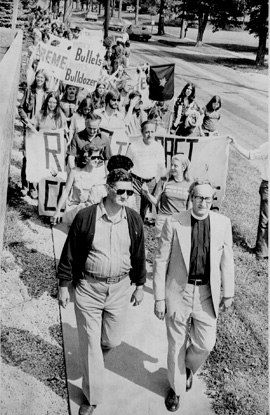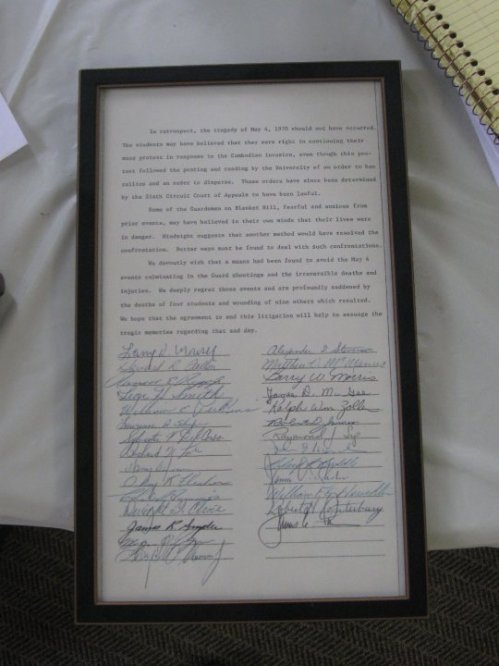LAUREL KRAUSE, April 25, 2011
 HERE WALKS my dad, Arthur Krause with Reverend John Adams and other protesters on his last trip back to Kent State. His daughter and my sister, Allison Krause, was slain at Kent State University in the student protest against the Vietnam war on May 4, 1970, a day that forever changed our family and civil rights in America … a day that changed America.
HERE WALKS my dad, Arthur Krause with Reverend John Adams and other protesters on his last trip back to Kent State. His daughter and my sister, Allison Krause, was slain at Kent State University in the student protest against the Vietnam war on May 4, 1970, a day that forever changed our family and civil rights in America … a day that changed America.
Approaching the anniversary of Allison’s killing, the energy from that time calls out with new evidence and the truth. Current events and the emergence of new evidence in the Kent State Strubbe tape http://bit.ly/1gcCCWo, demanding we as a democratic, just nation must re-examine what went down in the sixties, ending at Kent State on May 4, 1970 … when the state slaughtered protesters, a crime against man.
A remarkable cosmic signpost arrived on March 11, 2011 when a 7.1 earthquake struck Japan, creating a tsunami that came to our shores with the emerging Fukushima nuclear disaster. Very early that morning I awakened to a reverse-911 telephone call recommending those near water and inlets on the coast move to higher ground for safety from the approaching tsunami due at 7:23am, my account here http://bit.ly/gOovLw Article on the north coast tsunami and damage to the harbor in our community ~ http://bit.ly/gWy090
As I waited at higher ground from 7:00 am on into the afternoon, I realized how this world event had transformed humanity … the way we live together globally. Hours after that massive shake, we were shown on every level that what happens there, happens here as we are all connected on this third planet from the sun.
Most importantly, the nuclear event at Fukushima shows us the deeply polluting, over-reach of corporations, echoing George Orwell’s 1984 and Kurt Vonnegut’s Cat’s Cradle. Fiction from the 60’s now becomes commonplace reality in 2011.
General Electric, the developer of the nuclear technology used at Fukushima also conceived the overall design, organized the construction and manufacture of Fukushima’s parts. GE literally put together the concept behind and the ‘gears’ of the Fukushima nuclear reactor.
Yet following this tsunami in Japan and the nuclear alert created at Fukushima, GE’s first step was to protect their corporate interests and distance the General Electric, GE brands, claiming TEPCO’s majority ownership. Corporate-owned media machines backed them by never referring to General Electric as a player in this nuclear horror, following the same playbook as the BP Deepwater Horizon disaster and the BP brand from last year.
GE continues to disassociate itself from Fukushima and in these actions, GE takes no responsibility for the nuclear plant they designed and built years ago, pointing the finger instead at their customer and partner TEPCO, another corporation.
We also see how the Corporatists eat their own, shown last week with BP bringing lawsuits against Transocean and the blow-out protector manufacturer. Each of these players, along with BP, are clearly responsible for the world’s worst oil disaster and how it continues to evolve ~ polluting, degrading and jeopardizing the eco-health of a large portion of planet Earth.
When will these offending corporations take responsibility and engage in the required significant remedial clean-up (as in making whole again) as well as thorough research or analysis of the eco-damaging event? When will we demand accountability and hold their feet to fire? To date that is nothing beyond a handful of lawsuits, pay-outs, fines and, yes, bonuses and awards in 2010 to Transocean for safety, of all things.
Lest we not forget newly-awarded energy contracts just signed by the US government and BP. Or the two TEPCO-directed nuclear plants to be built in Texas with $4B of tax payer-derived funds. All’s going great in eco-disasterville for Corporatists in America.
Back to Fukushima, the US nuclear energy lobby and US reactor manufacturers (top players, GE & Westinghouse-now Hitachi) without pause, continue skipping down the same development path, lacking proven safety procedures and offering not one innovative effort to safely begin bioremediating the nuclear disaster as it unfolds in Japan.
Just days after Fukushima began it’s radiation spew and without missing a beat, President Obama announced US commitment to continue to fund and develop new nuclear reactors as a key energy technology for our country. As their response to Fukushima, China, Germany and many other countries have placed moratoriums on new development in nuclear energy with Germany going a step further to begin de-commissioning every nuclear reactor there.
At my local supermarket a colleague whispered that the GE engineers, the guys that originally conceived of these water boiling nuclear reactors for GE, left the corporation quickly thereafter, quitting to become anti-nuke advocates. They realized the power unleashed in the technology they created, along with humanity’s inability to control or harness nuclear fission in a disaster scenario … like a tsunami.
Going back more than 40 years ago and related to nuclear energy, I remember heated arguments around the Krause family dining room table circa 1967-69. Allison, my sister, was 16-18 and I was 12-14. Dad was pro-Vietnam war, voted for President Johnson and worked in management at Westinghouse Electric Corporation. Because of this Dad was de facto pro-nukes. Allison was against the Vietnam war her friends were being drafted into and against the dangers of nuclear weapons as well as nuclear reactor manufacturers. I stood with Allison, Mom with Dad, as the nightly battles ensued.
Before Allison and I were born, Dad came home from WWII and he married my mom Doris. They moved to Chicago where he studied at Illinois Institute of Technology. His first job was at Westinghouse and it became his lifelong employer, common back then.
His employment at Westinghouse Electric Corporation was a big part of our family life. My folks first settled in Cleveland, Ohio. Then in 1963 we moved to Westinghouse headquarters in Pittsburgh, PA. From there we moved to Wheaton, Maryland with dinner arguments as Allison found her voice, progressing through high school.
Going back to 1967, the emerging counter-culture energies of the sixties were in high gear ~ like we have never really seen since. As a pre-teen, I looked up to my older sister by four years and we stood together as a united front against our parents, reflecting the generation gap back then.
TV news blasted widespread unrest, chronicling national protests as we watched bloody Vietnam warfare footage with body-bags of returning killed American soldiers. Many of the dead draft-age men had never voted for or against the war as the voting age was 21, changing to 18 in 1971.
Back then our folks, especially Dad was a lifelong democrat, supporting President Johnson’s Vietnam war. Allison locked horns with Dad about the war and how he made his living, his jobs at Westinghouse involved streamlining systems, progressing to creating the computerized shipping & tracking systems for shipping Westinghouse nuclear reactor parts worldwide.
Allison and most everyone her age back then was pissed off at the US Government. By 1968, Allison was protesting the draft and the war in Vietnam with all her friends … no one wanted to die for the war in Vietnam. Male friends her age were required to participate in a lottery, being drafted into the war. To escape the draft, many peaceful folks enrolled in college or dodged the draft by going to Canada as it became impossible to get Conscientious Objectors status. If you drew a bad lottery number based on birthdate, you were forced to make some very serious decisions.
As the Vietnam war progressed and President Nixon was elected in ’68, Nixon grandstanded on his secret plan to end the war as he covertly full-throttled secret bombings in Laos and Cambodia that started early in his first term in 1969.
Stoking the embers of the Indochine wars and the war at home, President Nixon and his co-hort were working with the Huston Plan http://bit.ly/gIYTD1 taking aim at America’s younger generation like a enemy camp. At the end of the 60s, it had become open season on American youth against the war … a tsunami of persecution, including deadly harassment from the Nixon administration, the Dept. of Justice, the FBI, cointelpro … doing it the J. Edgar Hoover way with help from the Dept. of Defense. Check out this photo album on the folks behind the Kent State Massacre. http://on.fb.me/hFGAgK
Back to the Krauses, as mentioned there was a riff about how Dad made his living. Dad was a well-respected and forward-thinking manager at Westinghouse Electric. He loved his job and enjoyed fixing systems so our family was transferred to plants that needed his help. As a young kid I remember Dad’s work colleagues greatly respecting his contributions. Years later Dad would receive the coveted Westinghouse ‘Order of Merit’ for his superior and lifelong contributions.
In our home back then, my sister and I did not share that pride for our father’s work. We also knew that by-products from nuclear reactors contributed to the manufacture of nuclear weapons, something else we were wishing to eradicate. We felt the conflict around Dad’s activities and the income he provided at the expense of our safety on Earth and our environment. We knew it back then and brought it to his attention.
That wound between Dad and Allison never healed. Allison continued to protest against the war and for honoring our environment.
In a ruinous, forever-changing chapter for our family, Allison Krause became one of four students slaughtered by the US government on May 4, 1970 as she protested the Vietnam War, the draft and the military occupation of her campus, Kent State University. Allison stood for peace, saying on May 3rd, “What’s the matter with PEACE? Flowers are better than bullets.”
The day after Allison’s death, in our backyard Dad made his plea before television cameras and in TV sets across America. In Dad’s passionate and emotional speech, he demanded that Allison’s “death not be in vain’ as he recanted about Allison:
She resented being called a bum because she disagreed with someone else’s opinion. She felt that our crossing into Cambodia was wrong. Is this dissent a crime? Is this a reason for killing her? Have we come to such a state in this country that a young girl has to be shot because disagrees with the actions of her government?
As Dad learned his eldest child was murdered by the US government as she protested the Vietnam war, something he didn’t agree with, he fought back for Allison’s stolen life and civil rights ~ for the lives and rights of Jeffrey Miller, Sandy Scheurer and William Schroeder on May 4, 1970.
Within the year President Nixon’s men strongly encouraged my folks to stop demanding investigations, drop every legal inquiry, offering Arthur Krause bribes for millions of dollars and my father turned them all down. Just the same, our family was put under surveillance by the FBI for years, continuing to this day.
The Kent State law suits were heard in court houses all the way to the US Supreme Court and back over the next nine years. In 1979, Dad’s efforts settled at $15,000 with a plaintiff’s civil settlement statement and the ‘statement of regret’ was personally signed by each of the guardsmen that shot at Allison, along with their commanders ~ something Dad insisted on.
Dad fought for Allison’s right to protest and her murder at the hands of the United States government until the end of his days. Arthur Krause knew that the murders at Kent State 1970 were personal for us, yet important for all.


